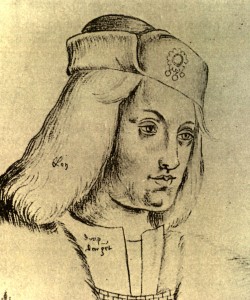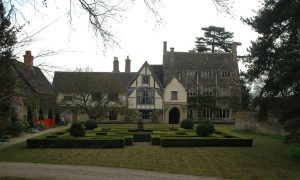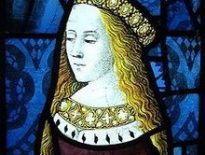Born around 1474, Katherine Gordon was the daughter of George Gordon, second Earl of Huntly, and Elizabeth Hay. Her father acted as Chancellor of Scotland from 1498 to 1501. Little is known of Katherine’s early life, but she was reputed to be beautiful and charming. The future Henry VIII is said to have ‘marveled at her beauty and amiable countenance, and sent her to London to the Queen’. On 13 January 1496, when she was about twenty-one, Katherine married the Yorkist pretender Perkin Warbeck. Her husband had claimed to be Richard, Duke of York, son of Edward IV, since 1491. The prince had been incarcerated in the Tower of London by his uncle Richard III in 1483, and his fate was still unresolved eight years later. In 1495, Perkin arrived at the court of James IV of Scotland, having previously been supported by Charles VIII of France, Emperor Maximilian and Margaret, Dowager Duchess of Burgundy. Shortly after his marriage to Katherine, Perkin was granted Falkland Palace as a base for his adherents and as the headquarters at which his invasion of England was planned. Henry VII of England, in response to Warbeck’s activities, prepared an army with which to invade Scotland.
Little is known of the nature of Katherine’s marriage to Perkin; whether she actually believed that her husband was the younger son of Edward IV is uncertain. Warbeck arrived in England at Whitesand Bay in Cornwall in September 1497, a few months after rebellion had broken out in Cornwall caused by the king’s perceived excessive taxation demands. Warbeck’s force, which allegedly numbered eight thousand, besieged Exeter on 17 September. They were rebuffed by the Earl of Devon and his army, and eventually withdrew to Taunton. Warbeck and his army escaped on 21 September when news reached them of the advance of the king’s army. With three of his companions, Warbeck entered sanctuary at Beaulieu Abbey in Hampshire. He was seized and taken before the king at Taunton Castle in October, where he confessed to being an imposter. At this time, Katherine was also in sanctuary, at St. Buryan. After her husband’s confession, she entered the service of Henry VII’s consort, Elizabeth of York. If he had succeeded in fooling her, Katherine might have believed that her husband was actually the queen’s younger brother, but if so his confession swiftly put paid to that notion.
Warbeck accompanied the king on his progresses until the summer of 1498, when he escaped and hid in the Charterhouse at Sheen. He was subsequently imprisoned in the Tower of London. The following year, he was alleged to have plotted with the royal prisoner Edward, Earl of Warwick to escape from the Tower and seize the throne in one of their names. Tried and found guilty, Warbeck was executed on 23 November 1499 at Tyburn; the earl was beheaded a few days later. How Katherine responded to these developments is unknown, but she did not suffer greatly from the loss of her husband, in the sense that she was treated generously by Henry and Elizabeth and continued to reside at court. The Privy Purse accounts record gifts made to Katherine by the king and queen. On 25 January 1503, she witnessed the proxy marriage of James IV of Scotland and Margaret Tudor, and acted as chief mourner at the funeral of Elizabeth of York the following month.
During the reign of Henry VIII, Katherine received the manors of Philberts at Bray and Eaton at Appleton, both in Berkshire. By 1512, she had remarried. Her second husband was James Strangeways of Fyfield, then in Berkshire. Strangeways was a gentleman usher, but their marriage was to prove short-lived. Katherine married for the third time in about 1517 to Matthew Craddock of Swansea; her husband provided her with an income derived from the lands of Dinas Powys and Llanedeyrn. Matthew’s date of death is unknown, but Katherine married for the fourth and final time to Christopher Ashton of Fyfield by about 1531. She died at the end of 1537, aged about sixty-three. Katherine was buried at the church of St. Nicholas in Fyfield. It was an obscure end to a dramatic life in which Katherine had been the wife of an infamous pretender, the reputed Richard, Duke of York, and the recipient of marked royal favour.
Conor Byrne is the author of Katherine Howard: A New History and Queenship in England: 1308–1485 Gender and Power in the Late Middle Ages. He is a British graduate with a degree in History from the University of Exeter. Conor has been fascinated by the Tudors, medieval and early modern history from the age of eleven, particularly the lives of European kings and queens. His research into Katherine Howard, fifth consort of Henry VIII of England, began in 2011-12, and his first extended essay on her, related to the subject of her downfall in 1541-2, was written for an Oxford University competition. Since then Conor has embarked on a full-length study of Queen Katharine's career, encompassing original research and drawing on extended reading into sixteenth-century gender, sexuality and honour. Some of the conclusions reached are controversial and likely to spark considerable debate, but Conor hopes for a thorough reassessment of Katherine Howard's life. Conor runs a historical blog which explores a diverse range of historical topics and issues. He is also interested in modern European, Russian, and African history, and, more broadly, researches the lives of medieval queens, including current research into the defamed 'she-wolf' bride of Edward II, Isabella of France.
Conor has just completed his Masters.





Richard and Edward were not incarcerated in the Tower. The Royal Apartments in the Royal Palace at the Tower was the most appropriate place as they were officially being prepared for Edwards coronation. It was only after they were declared illegitimate that they were moved as the Royal Apartments were no longer appropriate. There is no evidence that they were incarcerated. They were seen in the Garden Tower as late as September 1483. It is likely that they were under protective custody and later moved to the North. Although there were strong rumours that they had been killed during or after the Summer 1483, there has never been strong evidence for this or their continued survival. One possible fate of Edward is that he died naturally as he was attended by his doctor for several weeks but why not give him a public funeral? Even killing them, they would have been shown and publicly buried. There are plenty of ways to kill a couple of kids at night, horrible as it was, even for those times. However, Richard said and did nothing. This was probably because they were not dead, but discreetly moved to close protective custody in the North of England, in secret. This has been discussed in recent works and is only one of a number of fates. The problem is, nobody really knows, the two ex Princes simply vanished.
Richard of England, Duke of York as his followers called him was very convincing. Margaret of York, Archduchess of Burgundy (Flanders) and Emperor Maximillan I supported him, the King of France supported him, the Irish Lords supported him, many of Henry’s own nobles supported him, the King of Scots supported him for his own reasons and the Cornish used his invasion to cover their rising in 1496 and 1497.
James Iv of course saw an opportunity to invade England and he may not even have cared about who Richard (Perkin in the official version) was. The Earl of Huntley certainly didn’t care about possibly marrying his daughter, Lady Katherine Gordon to a commoner. She was the cousin of the King and possibly the daughter of Joan Beaufort, so she had a Lancaster claim which united with York. Richard wrote her chivalrous and romantic letters and they were genuinely affectionate. It is debatable as to whether or not they had children.
Katherine seems to have supported her husband and his claim. It has been speculated that it was to protect her that he eventually surrendered and was handed over when he sought Sanctuary. Katherine was treated as a guest at court and so at first was her husband. It was only after he escaped and was recaptured as a way to get rid of him and encouraged the hapless Earl of Warwick to do the same that Richard was forced to confess to being Perkin Warbeck and to deny his claim. He had invaded three times and failed. With pressure to reveal him as an imposter, not just a pretender coming from Spain before they agreed to conclude a treaty for the hand of Catherine of Aragon to Prince Arthur intensified Henry was under great stress to find out who he was. Several testimonials have been shown to identify him as Perkin Warbeck or Osbeck from Tourney, all of which follow the official party line. It has been shown that his confession was dodgy and his face was badly beaten beyond all recognition when he appeared in public after he was displayed in London, before his trial in 1499 and his execution. He was also hung as a felon. It has been speculated that he accepted his fate on a guarantee of the safety of Lady Katherine and possibly even his son.
Lady Katherine did remain in the English Court and she was married another three times. Henry remained her friend and he became her confidante after his wife’s death. She was not his mistress but he did remain close to her. She remained in favour under Henry Viii and at one time had a beautiful tomb when she died but it was dismantled later. She appears to have been a beautiful woman and intelligent one.
I suppose it depends on how you define “incarcerate”. It has all kinds of meanings “imprisoned, detained, confined, locked up, held, taken into custody…”. I think we can say that they were confined to the Tower, whatever the initial reasoning behind it. I’m not sure it can be said that it is “likely” or “probable” that they were moved north, although it is a possibility. It is frustrating that we do not know their fates and I still can’t make my mind up over the various theories.
It is correct to say that they were confined in the Tower, even if they were in the royal palace as the royal palace was in the Tower confines. We talk about Anne Boleyn being imprisoned in the Tower and she was also in the royal complex.
Anne Boleyn was arrested and held for treason and so a prisoner, if innocent so the term incarcerated is appropriate. But Anne was also in the Tower for her coronation but not held.
It much depends on how you see things and when Edward and Richard were in the Tower. At first Edward was not held. He was housed as his status befitted as a new King, originally to wait for his coronation. Richard joined his brother when he was handed over with ‘encouragement ‘ but Elizabeth Woodville had no choice. However, it was right that he should join his brother. He would have had his own household in the normal course of events, but their status changed. This is were the confusion begins and the information becomes garbled.
As children who were no longer royal they had to move to another part of the palace, because Richard, Duke of Gloucester soon needed the royal apartments as he was now elected King by the three estates of the realm, as the two boys and their sisters had legally been made illegitimate. I say legally in the sense that a process had examined the marriage of Elizabeth Woodville and Edward iv and found it wanting, because according to the “evidence” or testimony of the Bishop Shillington King Edward IV had previously married or agreed to marry and contracted himself to Eleanor Talbot, daughter of the Earl of Shrewsbury who was still alive during the early years of his marriage to E W. Another process had made this public and a later process confirmed it in Parliament. What that process was and if a hearing was needed has been debated but under English Law a full court hearing may not have been needed if the parties were deceased. Several law journals have confirmed this. Not all historians accept the contract but many do and it only needed Richard to believe it, not historians. There is no strong evidence that Richard was planning to become King before his brothers lack of memory when it came to marriage was made public. However, if the boys were no longer legitimate, then he was the next lawful heir and it was inevitable that he would become King. This is the change in his nephews status that changes how they are kept in the Tower.
We know that they were not prisoners because they had medical care, visitors, the use and freedom of the palace gardens and bills for their garments suggest that they had high status and care for a time at least. The question is how long were they at the Tower? After Richard’s coronation he went off on progress north and he left them behind. Reports vary on when they were last seen and how they were held. From the end of July they were held in some form of close protective custody because there was an attempt to spring them which failed. Incarcerated may not be entirely correct but may be assumed because we don’t know if they were under lock and key or not. Once word of an attempt to spring them was in the air and made it is clear they were under closer guard and that may have been protective custody, held in another part of the White Tower, rather than the less secure Garden Tower, incarceration in a suite of rooms or some form of being held in temporary custody until the King returned. Any of the terms could apply in this period, although protective custody is probably closer to their actual situation. The sources are not in agreement either on the last time Edward and Richard were seen or known to be alive, let alone what happened next. Between the end of July 1483 and September 1483 they disappeared, at least from the public eyes although they had medical attention right through the summer. After that anything is possible.
What is possible has been recently examined by Matthew Lewis in his book Search for the Princes in the Tower and there are tantalising bits of evidence which point to their potential survival and movement from the Tower. One possible outcome was that they moved north to Richard’s strongholds in Middleham or some other castle. It seems that rather than leave two boys who could be used as trouble in the capital, it was more sensible to move them north where other family members were and his Council of the North kept security. It is very possible that Richard on his return to London may do this. However, it is only one of a number of fates and it certainly is a shame we don’t know what happened to them.
It’s because, despite the rumours in London and France and elsewhere, that Richard had killed his nephews and they were dead, or Buckingham had killed them, that nobody knew for certain at that time what had happened. There were rumours of their survival as well and during Henry Tudors early reign it was never quiet and pretenders came out of the woodwork. Henry never really knew if they lived or died and he was constantly afraid that they lived. This was particularly true of the Perkin Warbeck affair.
Margaret of York, sister of Richard iii and Edward iv, supported the claim of Richard of England to be the real Duke of York and for several years he was a danger to Henry Vii. He invaded three times, had support in Ireland, France, Flanders, Venice and the Holy Roman Empire. Only Spain didn’t support him, despite his elegant letters to Queen Isabella whom he called cousin. Even as Richard of England as he was commonly known was being ‘unmarked ‘ by Henry’s spies as a commoner, he was still only called Duke of York in diplomatic correspondence. Whether this Perkin Warbeck or Osbeck was an imposter or the true Richard, son of Edward iv or an illegitimate son, as is often believed now, he scared the living daylights out of the new Tudor King and his young family were in real danger. His support came to the heart of the court. Henry was so desperate to have him only seen as a foreign commoner that he had his face badly beaten at least twice. It is not possible to prove that the young man hung at Tyburn in 1499 was who he had claimed to be because his body was buried in a place that there is no longer access to and has probably become lost, so we can’t use DNA to solve yet another mystery around the Princes in the Tower.
That Lady Katherine Gordon refused to deny her husband and wanted to remain with him shows a woman of conviction and courage. It has been speculated that it was to protect her that Richard of England made his official confession and wrote a very odd letter to his ‘mother ‘. To watch the man she had been married to for almost three years and with whom she may have had a child, first deny his birth right after upholding his claim for seven years in public, then to read an humiliating confession in public and then to be hung as a common felon at Tyburn must have been heart breaking. Yet Katherine was clearly a woman of pride and dignity who didn’t hold malice in her heart because she became a close friend to the man who had killed her husband. I can’t begin to imagine how she did that. I believe, but can’t prove that she did have a baby who may have died in early childhood. Elizabeth of York must have been completely torn during those turbulent years of 1493 to 1499, not knowing to side with her husband and King, the father of her sons and daughters, to whom she was bound or with a young man who may be her brother, preserved from death, but who she couldn’t accept as it meant admitting her life had been built on a lie. It is little wonder that Henry prevented Elizabeth from seeing Richard or Perkin as she may give him away as the true heir. Henry Tudor had reversed the Titular Regis which made his wife illegitimate in order to marry her and strengthen his claim to the throne, but when he did so, all of her siblings were declared legitimate. That meant this young man who had raised half of England and Scotland and much of Europe in his cause was also legitimate if he was indeed Prince Richard and had a better claim to the crown than Henry had. He had to go.
Ironically another Prince of York, Edward, Earl of Warwick, son of George, Duke of Clarence, brother of Richard iii and Edward iv, was another guest in the Tower. Henry had taken him into custody and he was definitely incarcerated or at least kept under guard since he was about ten in 1486,_when he also was used in a plot to unseat the new Tudor King. Henry feared this child but allowed him his inherited title and an allowance, but kept him under guard in the Tower because he had been called King by his supporters and he couldn’t risk him being used again. However, when Spain wanted to agree with an alliance with England and the marriage of their daughter, Katherine to Henry’s heir, Prince Arthur, they insisted that no rivals to the crown be allowed to live. Henry placed Warbeck and Warwick into the same room and they conspired to escape and this was also treason. The Earl was tried and beheaded. Leanne de Lisle claims he was backward but there is very little evidence to support this save that he couldn’t tell the difference between a chicken and a capon. His development may have been hindered but he wasn’t an imbecile. He was now about twenty three or four having been in custody for more than thirteen years.
Katherine Gordon was very much part of the household of Elizabeth of York but there is no evidence that she became anything but a friend to Henry after his Queens death and she was to go on to be a jewel at the Tudor court for another three decades. Although there is nothing to indicate that she was anything but loyal, I suspect that given who her first husband was, she was watched closely.
Sorry should read The Survival of the Princes in the Tower: Murder, Mystery, Myth. by Matthew Lewis.